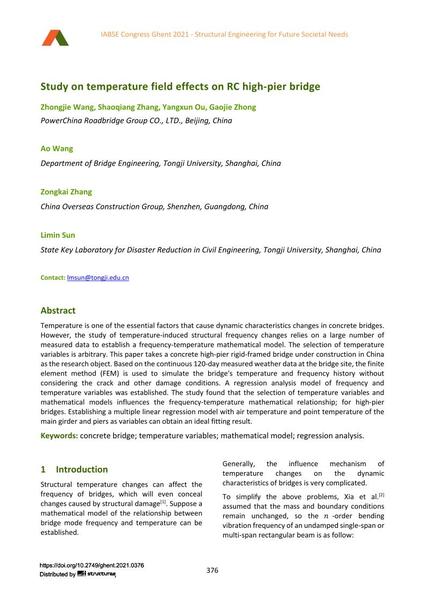Study on temperature field effects on RC high-pier bridge

|
|
|||||||||||
Bibliografische Angaben
| Autor(en): |
Zhongjie Wang
(PowerChina Roadbridge Group CO., LTD., Beijing, China)
Shaoqiang Zhang (PowerChina Roadbridge Group CO., LTD., Beijing, China) Yangxun Ou (PowerChina Roadbridge Group CO., LTD., Beijing, China) Gaojie Zhong (PowerChina Roadbridge Group CO., LTD., Beijing, China) Ao Wang (PowerChina Roadbridge Group CO., LTD., Beijing, China) Zongkai Zhang (PowerChina Roadbridge Group CO., LTD., Beijing, China) Limin Sun |
||||
|---|---|---|---|---|---|
| Medium: | Tagungsbeitrag | ||||
| Sprache(n): | Englisch | ||||
| Tagung: | IABSE Congress: Structural Engineering for Future Societal Needs, Ghent, Belgium, 22-24 September 2021 | ||||
| Veröffentlicht in: | IABSE Congress Ghent 2021 | ||||
|
|||||
| Seite(n): | 376-381 | ||||
| Anzahl der Seiten (im PDF): | 6 | ||||
| DOI: | 10.2749/ghent.2021.0376 | ||||
| Abstrakt: |
Temperature is one of the essential factors that cause dynamic characteristics changes in concrete bridges. However, the study of temperature-induced structural frequency changes relies on a large number of measured data to establish a frequency-temperature mathematical model. The selection of temperature variables is arbitrary. This paper takes a concrete high-pier rigid-framed bridge under construction in China as the research object. Based on the continuous 120-day measured weather data at the bridge site, the finite element method (FEM) is used to simulate the bridge's temperature and frequency history without considering the crack and other damage conditions. A regression analysis model of frequency and temperature variables was established. The study found that the selection of temperature variables and mathematical models influences the frequency-temperature mathematical relationship; for high-pier bridges. Establishing a multiple linear regression model with air temperature and point temperature of the main girder and piers as variables can obtain an ideal fitting result. |
||||
| Stichwörter: |
Betonbrücke
|
||||
| Copyright: | © 2021 International Association for Bridge and Structural Engineering (IABSE) | ||||
| Lizenz: | Die Urheberrechte (Copyright) für dieses Werk sind rechtlich geschützt. Es darf nicht ohne die Zustimmung des Autors/der Autorin oder Rechteinhabers/-in weiter benutzt werden. |
||||
